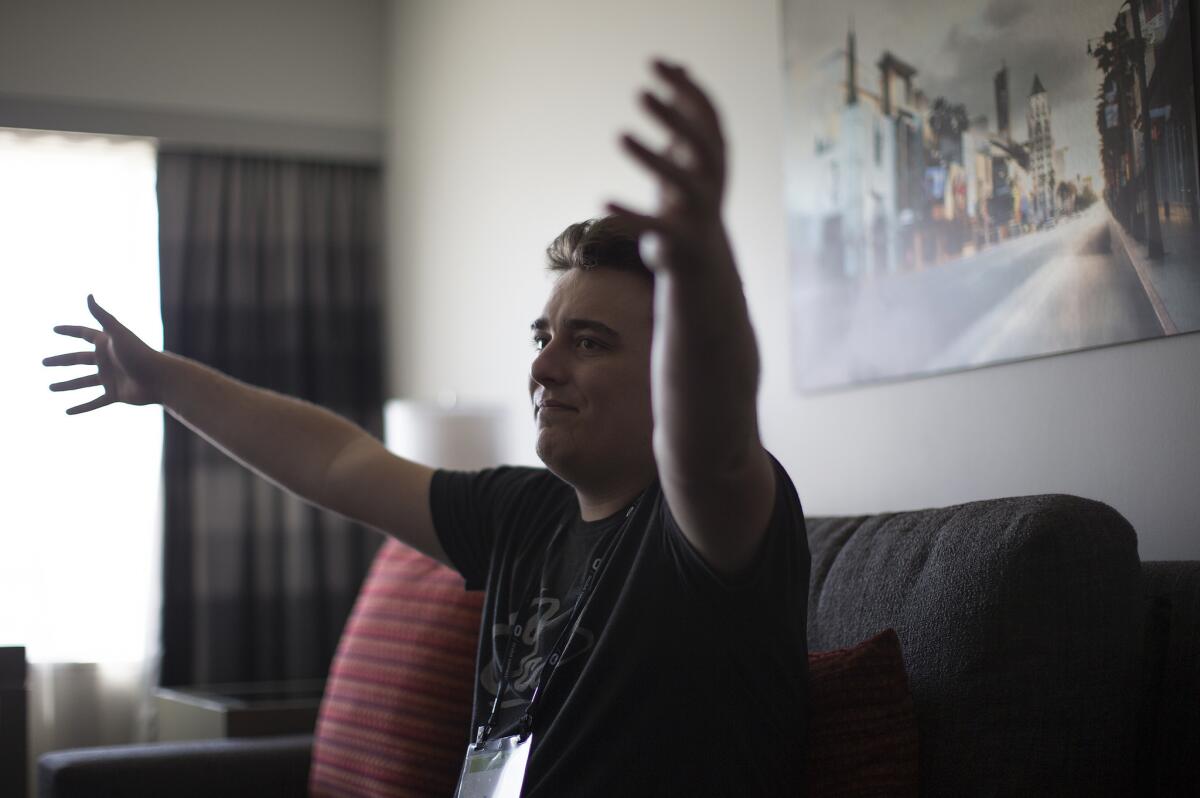Oculus VR founder Palmer Luckey talks GoPro, ‘Minecraft’ and eSports

Oculus VR founder Palmer Luckey answers questions at the Loews Hollywood Hotel on Sept. 24.
- Share via
A few years ago, journalism major Palmer Luckey dropped out of Cal State Long Beach to work on a device that would wrap a small computer monitor across a person’s face.
With the company he founded, Oculus VR, ready to finally sell those virtual-reality display goggles to consumers early next year, the 23-year-old Luckey is giddy. At a conference that Oculus -- now owned by Facebook Inc. -- held in Hollywood last week, Luckey celebrated several announcements, including the development of a “Minecraft” app for virtual reality, tossing toy swords, T-shirts and more swag into a crowd of more than 1,500 people at the Dolby Theatre.
A few hours later, we asked him to elaborate as he sat on the edge of a hotel-room couch.
1. How bringing the popular construction game “Minecraft” required haggling and something tangible to show.
Two years ago, Oculus Chief Technology Officer John Carmack first asked the people behind “Minecraft” to consider a virtual-reality app version.
Getting “Minecraft” to prioritize virtual reality took a while, Luckey said. After Microsoft purchased “Minecraft” developer Mojang AB earlier this year, its employees have been preparing the game for new Microsoft devices.
But when Carmack pushed Mojang again, the company finally offered him special access to modify “Minecraft.” Oculus lawyers told Carmack that an onerous contract with Mojang had basically turned him into a Microsoft employee, but he saw “Minecraft” as being too important to give up on for any reason. He ended up turning heads at both companies with a modified “Minecraft.”
“I think John really proved you could make ‘Minecraft’ work well in VR, so everyone was like how can we get this out people?” Luckey said.
Carmack said Facebook Chief Executive Mark Zuckerberg and Microsoft CEO Satya Nadella got involved to finalize the deal.
2. Why watching Netflix on the Gear VR will be liking having a portable cinema.
Luckey’s answer: It’s better watching for 3D content than most 3D televisions, and it’s a portable experience.
The latter, of course, is only true for the Samsung Gear VR -- a $99, sort-of “lite” version of Oculus’ main headset. Unlike the flagship Rift, the Gear VR doesn’t need to be wired to a computer.
“You can have this virtual big-screen experience with something you can carry in your backpack,” he said.
Netflix on the Rift could more exciting once social features come to the app. One social possibility would be attending a virtual cinema with friends, creating the sensation that two people are side-by-side on a couch even though physically miles apart.
3. Why virtual reality will be about a lot more than games.
Luckey, a self-proclaimed “virtual reality nut,” said he tries every app for the Gear and Rift and offers feedback on most of them.
“Sometimes, it’s just, ‘Hey I tried your app. Good job,’” Luckey said. “Or sometimes, ‘I tried your app. You need to fix some things. It’s really bad.’ Hopefully, not the second one.”
His interests are vast.
“The idea of being able to take virtual field trips to places you can’t go to anymore, like ancient Rome or into the center of a volcano where there’s a heat-proof camera, that’s pretty cool for me too,” he said.
Luckey also cited a prediction Carmack offered hours earlier that although games will get the most downloads and marketing attention on the headsets initially, they’ll account for less than half of virtual-reality app usage eventually.
“Right now, the people with technology, the tools and the talent to make virtual reality all possible are in the game industry,” Luckey said. Hollywood is next in line, and other industries will catch up, he said.
4. Why testing computers and labeling them “Oculus Ready” will make virtual reality more affordable.
Running the Rift requires a powerful graphics card, normally found on only expensive computers. Luckey said partnering with manufacturers brings down prices to enable more people to afford the setup.
Through Oculus Ready, the company can collaborate with computer manufacturers to improve weak parts or eliminate costly parts, like say an exorbitant amount of memory, that don’t contribute to running the Rift.
No “overpaying for things you don’t need,” Luckey said.
5. Why competing with GoPro on cameras isn’t going to happen.
Creating videos that look cool in the Rift and Gear requires a camera capable of shooting really wide angles, so when a user in a headset tilts their head they can see the broader perspectives. Luckey cited the $350 Ricoh Theta as today’s best filming option, but said more are coming.
Oculus is working with camera manufacturers to design so-called 360-degree cameras, though it won’t make any itself, Luckey said.
“It doesn’t make sense for us to compete with GoPro in a market they really know and own,” he said. “The same goes for all the other camera companies working on VR.”
6. How virtual reality will change eSports – the spectator part first.
Oculus is building ways for people to stream video of virtual-reality gameplay onto the Internet, like people already do for computer games. But since virtual-reality games will start out as a niche, they won’t turn hypercompetitive overnight.
More immediately, it’ll be the spectator side of professional video-game competitions that gets a boost from virtual reality, Luckey said.
Live-streaming services such as Twitch could build “virtual arenas” where people donning a headset gather in a digital world to watch matches.
“You can feel like you’re there with your friends,” Luckey said. “I think that will change how eSports works when you can have lots of people watching in a virtual environment.”
7. Why overlooking the old-school controller is a mistake.
The Rift will work with two controllers by the end of summer 2016 -- an Xbox One gamepad and a handheld motion-sensing gadget called Touch. All the Touch games seem great, and fit well with the Rift’s futuristic feel. So what’s the role of the gamepad?
The gamepad was meant to hold down the Rift’s price and give an assurance to app developers that every Rift owner would have at least one common controller.
“Bundling a gamepad was a fairly insignificant cost, especially in the quantities we’re getting them and in working with Microsoft,” Luckey said.
Touch enables new experiences, like a new art-design app called Oculus Medium. Virtual sculpting and painting benefit from the more free-form movements Touch allows. But in a racing game, two hands tightly gripping a gamepad feels natural.
“There’s a lot of games that will be definitely be better on a gamepad,” Luckey said.
Chat with me on Twitter @peard33







